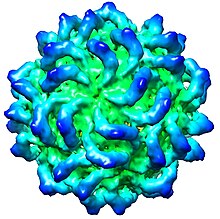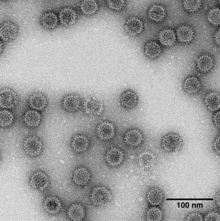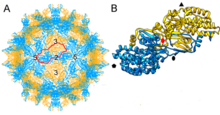
An RNA virus is a virus—other than a retrovirus—that has ribonucleic acid (RNA) as its genetic material. The nucleic acid is usually single-stranded RNA (ssRNA) but it may be double-stranded (dsRNA). Notable human diseases caused by RNA viruses include the common cold, influenza, SARS, MERS, Covid-19, Dengue Virus, hepatitis C, hepatitis E, West Nile fever, Ebola virus disease, rabies, polio, mumps, and measles.
A satellite is a subviral agent that depends on the coinfection of a host cell with a helper virus for its replication. Satellites can be divided into two major classes: satellite viruses and satellite nucleic acids. Satellite viruses, which are most commonly associated with plants, are also found in mammals, arthropods, and bacteria. They encode structural proteins to enclose their genetic material, which are therefore distinct from the structural proteins of their helper viruses. Satellite nucleic acids, in contrast, do not encode their own structural proteins, but instead are encapsulated by proteins encoded by their helper viruses. The genomes of satellites range upward from 359 nucleotides in length for satellite tobacco ringspot virus RNA (STobRV).

Nanoviridae is a family of viruses. Plants serve as natural hosts. There are currently 12 species in this family, divided among 2 genera and one unassigned species. Diseases associated with this family include: stunting. Their name is derived from the Greek word νᾶνος, because of their small genome and their stunting effect on infected plants.

Closteroviridae is a family of viruses. Plants serve as natural hosts. There are four genera and 59 species in this family, seven of which are unassigned to a genus. Diseases associated with this family include: yellowing and necrosis, particularly affecting the phloem.

Tombusviridae is a family of single-stranded positive sense RNA plant viruses. There are three subfamilies, 17 genera, and 95 species in this family. The name is derived from Tomato bushy stunt virus (TBSV).
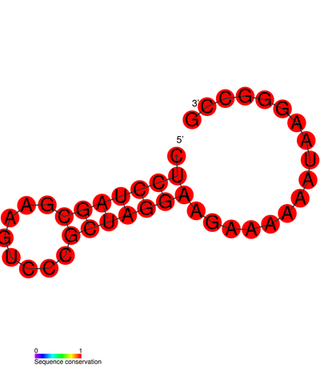
Closterovirus, also known as beet yellows viral group, is a genus of viruses, in the family Closteroviridae. Plants serve as natural hosts. There are 17 species in this genus. Diseases associated with this genus include: yellowing and necrosis, particularly affecting the phloem. This genus has a probably worldwide distribution and includes among other viral species the Beet yellows virus and Citrus tristeza virus, rather economically important plant diseases. At least some species require vectors such as aphids or mealybugs for their transmission from plant to plant.

Mycoviruses, also known as mycophages, are viruses that infect fungi. The majority of mycoviruses have double-stranded RNA (dsRNA) genomes and isometric particles, but approximately 30% have positive-sense, single-stranded RNA (+ssRNA) genomes.

Totivirus is a genus of double-stranded RNA viruses in the family Totiviridae. Fungi serve as natural hosts. The name of the group derives from Latin toti which means undivided or whole. There are seven species in this genus.

Nepovirus is a genus of viruses in the order Picornavirales, in the family Secoviridae, in the subfamily Comovirinae. Plants serve as natural hosts. There are 40 species in this genus. Nepoviruses, unlike the other two genera in the subfamily Comovirinae, are transmitted by nematodes.

Alphachrysovirus is a genus of double-stranded RNA viruses. It is one of two genera in the family Chrysoviridae. They infect fungi, in particular Penicillium. Their name is derived from the Greek word chrysos which means yellow-green. There are 20 species in this genus.
Dianthovirus is a genus of viruses, in the family Tombusviridae. Dianthoviruses are plant viruses. There are three species in this genus. The virus probably has a worldwide distribution, and can be transmitted via nematodes, by mechanical inoculation, by grafting of plants and by contact between infected hosts with previously uninfected host.
Endornaviridae is a family of viruses. Plants, fungi, and oomycetes serve as natural hosts. There are 31 species in this family, assigned to 2 genera. Members of Alphaendornavirus infect plants, fungi and the oomycete Phytophthora sp., members of Betaendornavirus infect ascomycete fungi.
Hypovirus is a genus of viruses, in the family Hypoviridae. Fungi serve as natural hosts. There are four species in this genus. Infection reduces the virulence of its parasitic host, making it a hyperparasite useful for blight control.

Betaflexiviridae is a family of viruses in the order Tymovirales. Plants and fungi serve as natural hosts. There are 108 species in this family, assigned to 13 genera in two subfamilies. Diseases associated with this family include mosaic and ringspot symptoms.
Amalgaviridae is a family of double-stranded RNA viruses. Member viruses infect plants and are transmitted vertically via seeds. The name derives from amalgam which refers to amalgaviruses possessing characteristics of both partitiviruses and totiviruses. There are ten species in the family.

Victorivirus is a genus of viruses, in the family Totiviridae. Filamentous fungi serve as natural hosts. There are 14 species in this genus.
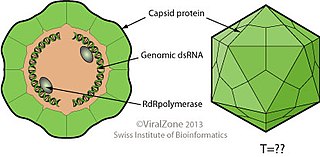
Megabirnaviridae is a family of double-stranded RNA viruses with one genus Megabirnavirus which infects fungi. The group name derives from member's bipartite dsRNA genome and mega that is greater genome size than families Birnaviridae and Picobirnaviridae. There is only one species in this family: Rosellinia necatrix megabirnavirus 1. Diseases associated with this family include: reduced host virulence.

Quadriviridae is a family of double-stranded RNA viruses with a single genus Quadrivirus. The fungi Rosellinia necatrix serves as a natural host. The name of the group derives from the quadripartite genome of its members where in Latin quad means four. There is only one species in this family: Rosellinia necatrix quadrivirus 1.
Cryspovirus is a genus of viruses, in the family Partitiviridae. Protists serve as natural hosts. There is only one species in this genus: Cryptosporidium parvum virus 1.

Orthornavirae is a kingdom of viruses that have genomes made of ribonucleic acid (RNA), those genomes encoding an RNA-dependent RNA polymerase (RdRp). The RdRp is used to transcribe the viral RNA genome into messenger RNA (mRNA) and to replicate the genome. Viruses in this kingdom also share a number of characteristics involving evolution, including high rates of genetic mutations, recombinations, and reassortments.
